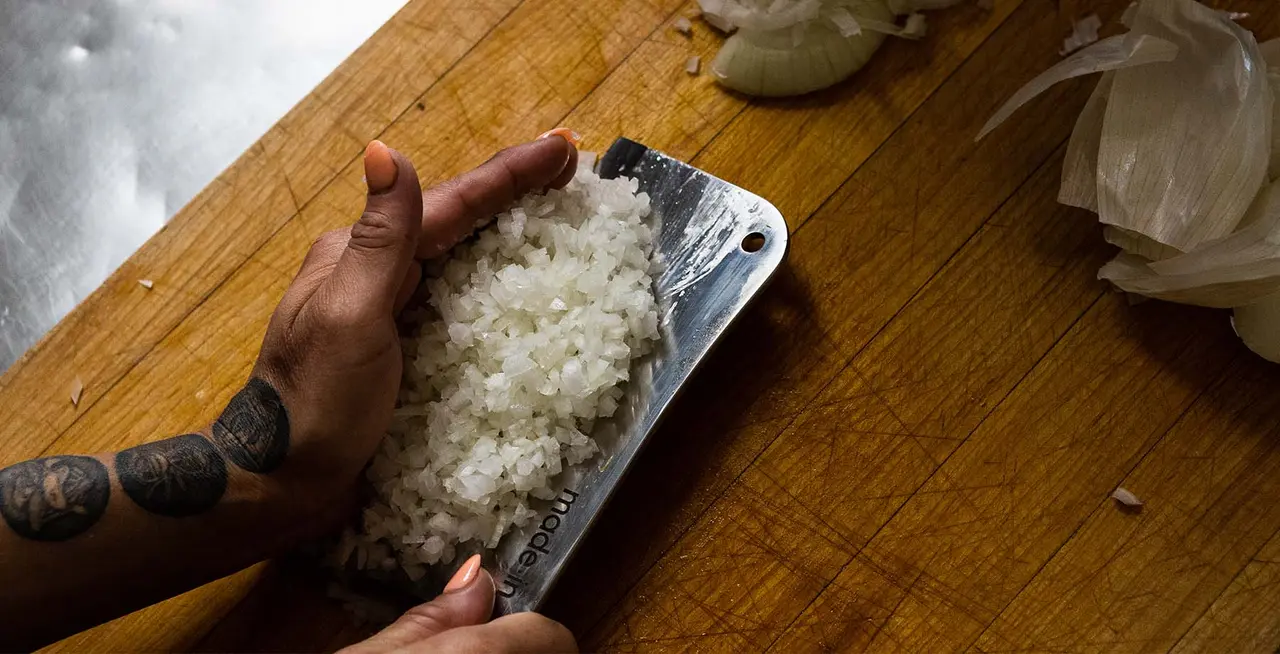The cleaver is one of the more misunderstood knives in Western kitchens, as they are typically thought of as strictly tools for butchery, slicing around bones, and breaking down large cuts of meat. In Japanese and especially Chinese cooking, cleavers are treated more like a chef knife, used for both meat and vegetables with different sizes for different tasks.
Janie Ramirez, Executive Chef at Austin's Dai Due, agrees with this treatment of cleavers. While Dai Due is known for their meats—and their commitment to sourcing their proteins as locally as possible—they also use vegetables in creative ways. Chef Ramirez believes that the cleaver can be used for both.
“It’s a really versatile knife—not just for meat but for vegetables, too,” she says. “The more you use it, the more comfortable it becomes in your hand, and then you can practically use it for everything.” Here, Chef Ramirez shares her five favorite ways to use the cleaver.
Slicing Through Boneless Meats

Cleavers are often advertised as a blade for bone-in meats. While it’s strong enough to slice through bone, we don’t recommend it, especially for larger animals. Repeatedly cutting into something that hard can cause damage over time, not only dulling but also nicking the blade. Chef Ramirez likes to use the cleaver for boneless cuts instead.
“It’s really nice for slicing boneless meats into strips,” she says. “Because of its weight and flat blade, you can easily cut through multiple strips at once to make cubes, and you can even mince meat finely enough with one to make a tartare.”
Splitting Open Tough Vegetables

Large vegetables with tough exteriors, like gourds, can sometimes be unwieldy and difficult to cut into. The weight of the cleaver, coupled with its wide blade, makes it ideal for this—you can even use it for watermelons or bulky root vegetables, like daikon radishes.
“Once I get the cleaver in, I use a mallet to tap it in half,” Chef Ramirez says. “The cleaver goes through pretty cleanly, giving you a nice split squash that you can scoop the seeds out and roast in half.” If you don’t have a mallet, you can also use the heel of your hand to tap the knife through, but work slowly and be very careful.
Crushing Garlic

The wide, flat blade of a cleaver is perfect for prepping garlic—both for removing the cloves from their skins as well as crushing them. “It can be a struggle to crush with other knives,” says Chef Ramirez. “So if I’m going to mince it, it’s nice to give it a little smack on the side because then you can go back and mince it and it won’t be wobbling around.”
The more you cut garlic, the stronger and more fragrant it will become, thanks to the release of the chemical compound allicin. Opting to crush garlic instead of mincing it is ideal for when you want a more mild garlic flavor and less bite to your dish.
The Rocking Method

Once you’ve smashed your garlic, you can then use the cleaver to mince it too—the size of the blade comes in handy here as well, because it’s easy to grip. Chef Ramirez especially likes it for the rocking method, which as the name implies, involves rocking the blade back and forth over an ingredient.
“I’ll hold the edge where the hole is and the handle,” she says. “Then, keeping the tip of the cleaver down, I’ll go across, back and forth, and then up and down." This technique works well for other aromatics, like ginger, lemongrass, and shallots.
Transferring From Your Cutting Board

Moving ingredients, especially small ones, from your cutting board to cookware can be a messy process. Rather than dirty another bowl or heave the cutting board around the kitchen, Chef Ramirez suggests using the cleaver like some chefs use bench scrapers.
“One of the best things about a cleaver is how big the face is,” she says. “This lets you pick stuff off the cutting board with ease and transfer it into a bowl or into the pan on your stove without dropping anything.”
When you’re scraping your ingredients from the cutting board, just make sure that you use the back of the knife so you don’t dull the blade—or get the cutting edge too close to your fingers.
Ready to Shop?
Our Olive Wood Cleaver is not only a versatile blade, but a beautiful one too. Its wide blade is sharpened at a 15-degree edge angle and is crafted from nitrogen-treated stainless steel for maximum strength. It also features a small hole so it can be hung, rather than stored in a knife block—traditional for cleavers used in butcher shops.
Like all of our Knives, our Cleaver is fully forged and full tang, meaning its blade runs from the tip of the blade all the way through the handle to result in an especially balanced and sturdy knife.






























